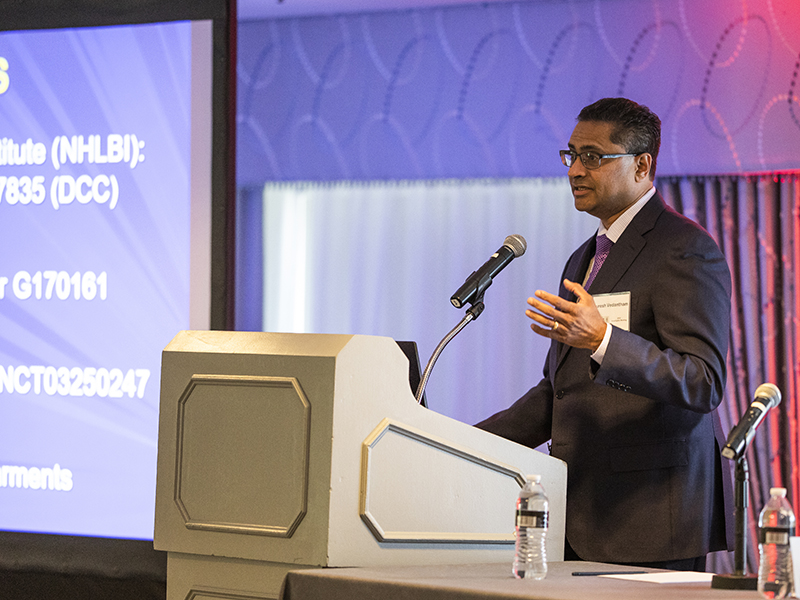Nearly anyone can develop a blood clot in their leg, a condition called deep vein thrombosis (DVT). But for 40% of patients, painful after-effects become a defining factor of their ability to live normal lives.
DVT is common, impacting up to 600,000 people in the U.S. each year, and can cause two kinds of problems. Blood clots can break off and cause a pulmonary embolism — which can be fatal. Or the clots can remain in the leg, prompting a reaction from the body that ultimately leads to permanent damage of the leg veins and ongoing symptoms for the patient — called post-thrombotic syndrome, or PTS.
Suresh Vedantham, MD, professor of radiology and surgery, leads a large-scale, NIH-funded trial called C-TRACT, which seeks to determine if image-guided therapy can improve the quality of life for those diagnosed with PTS. The standard treatment for blood clots is anticoagulants, which prevent the clot from moving to the lungs or recurrent episodes. But these medications aren’t enough to prevent debilitating PTS symptoms, which can include substantial leg aches or swelling that make walking and other activities difficult, and even skin ulcers in some patients.
“There has long been interest in finding ways to do more to prevent PTS because right now it is a lifelong condition with no cure, and it is difficult and expensive to treat,” says Vedantham. For the last 30 years, interventional radiologists pioneered and developed a procedure called catheter-directed thrombolysis (CDT) that uses imaging guidance to insert a catheter into the blood clot within the veins and then infuses a clot-busting drug to dissolve it. But there had been no study to determine if the benefits were worth the risks.
“The ongoing C-TRACT study builds on findings from a clinical trial we conducted to determine if the benefits of the CDT procedure on new clots outweigh the risks, which include internal bleeding,” says Vedantham about the ATTRACT study conducted from 2009-17.
ATTRACT was the first large-scale, rigorous study to address this question and is an example of the type of extensive, investigator-initiated, interdisciplinary, multisite research that Vedantham leads. To enable this experience to benefit more researchers, Vedantham, who also serves as assistant dean of clinical research for the School of Medicine, created Trial-CARE. The multidimensional clinical trial support service is implemented through the Center for Clinical Studies within the School of Medicine, in partnership with the Institute of Clinical and Translational Sciences.
“Trial implementation expertise is a skillset that needs to be viewed as complementary to disease state expertise. If you meld them together, you’re going to make the most impact doing clinical trials. Enhancing quality research is not just about regulating it; it’s also about actively supporting the investigator teams,” says Vedantham. He says his goal is to motivate the next generation of investigators who can use the platforms and pathways his team develops. “It’s very complicated to design and administer these multicenter trials, and Washington University previously hadn’t had a robust capacity to actively support them. But now we’re very well positioned to go to the next level of innovation. We’re essentially centralizing a cadre of highly experienced clinical research staff to support research teams and modernize the way we do clinical trials.”
The ATTRACT clinical trial, which was endorsed by the Office of the Surgeon General, involved 692 patients across 56 sites in the U.S., as well as 250 multidisciplinary investigators and experts. Results showed CDT didn’t stop PTS from occurring but did reduce the severity of symptoms of a subgroup of patients with acute iliofemoral DVT, a large blood clot that extends to the groin or higher.
“When we do these large-scale projects, we’re aiming not just at the one trial answering one question. Hopefully it influences the awareness of this disease process and PTS, which often doesn’t get recognized by medical physicians,” Vedantham says. After ATTRACT, the NIH encouraged the team to look for additional questions to answer, building on the substantive platform they had developed. “We zeroed in on the idea that patients who have vein blockage of any kind are likely to do better if a vein stays open or is reopened,” Vedantham says.
C-TRACT seeks to evaluate whether opening up the large iliac vein in the pelvis using stents can restore flow and reduce the severity of PTS in patients with old blood clots. With 173 of the 374 patients needed to participate, the study is nearly at the halfway point.
“By doing things in a rigorous way, teaching people about research methods, and encouraging interventional radiologists specifically to participate in ambitious studies, we can show that these kinds of studies are doable and answer important questions for our patients.”
Published in Focal Spot Spring/Summer 2023 Issue

